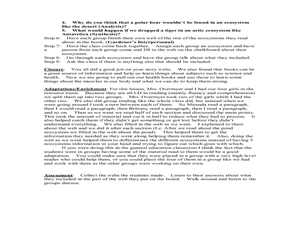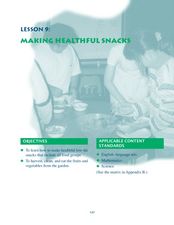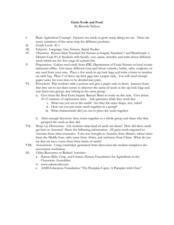Curated OER
Graphic Organizers Aid Comprehension
Students create story webs to aid comprehension of ecosystems. In this reading strategies lesson, students discover the importance of organizing information while reading a nonfiction text. Students produce story webs to communicate...
Curated OER
Making Healthful Snacks
Students examine how to make healthy snacks that include all the food groups and how to harvest, clean and eat fruits and veggies from the garden. In this healthy snack lesson plan students complete several activities that have to do...
Curated OER
Science and Politics in the Soviet Union
In this Soviet Union instructional activity, students read a 2-page selection about scientific work in the country and then respond to 4 short answer questions based on the selection.
Curated OER
A DAY WITHOUT AG
Students consider and discuss the meaning of the word "agriculture" and how agriculture affects their lives every day. Students identify the various ways that agriculture touches their personal lives. Students use worksheets to list all...
Curated OER
Read a Tonsil Poem
Students examine a poster to determine where the tonsils are located and listen as the teacher explains what the tonsils are used for. They read along as the teacher reads a poem about tonsils aloud. They discuss the poem to check for...
Curated OER
Grizzly Habitat
Students find areas on playground where they would live if they were a grizzly bear, share their reasons for their choice, talk about habitat areas, and choose their sites again, based upon new information.
Curated OER
A-maizing Facts
Students research the lives of Native Americans living in the Northeast Woodlands region, focusing on how the climate, location, and physical surroundings affected their way of life.
Curated OER
What's So Bad or Good About Conflict?
Young scholars investigate how conflict can be positive or negative. They discuss the concept of conflict while making a class web of their ideas. They design a class bulletin board that includes a thought written by each student after...
Curated OER
COLORS ON THE FARM
Students follow directions regarding what colors farm objects should be
colored. They identify various items pictured on provided worksheet that can be found on a farm or are made from farm animals. Finally, they match each color crayon...
Curated OER
A Tough Nut to Crack
Students study the origins and background of the pecan. In this agriculture lesson students divide into groups, complete an activity and worksheets.
Curated OER
What's In A Name?
Students analyze themselves as members of the community. They choose a name to describe themselves and explain why they choose the name they did. They identify activities they perform in and out of school to help the community.
Curated OER
Illegal Dumping
Students go on an outing and note garbage near picnic tables. They brainstorm ways to be involved with anti-litter campaigns and write letters to local officials.
Curated OER
Life Cycles
Students explore the life cycle of living things through the eight lessons of this unit. The butterfly, frog, chicken, and plant are inspected and form the basis of the work done in this unit.
Curated OER
Putting Together History Puzzle Pieces
Students attempt to put puzzle pieces together with no prior knowledge. This activity shows students at the beginning of the year that history is like a puzzle, there are often missing pieces, and many ways the pieces can turn to look...
Curated OER
Grain Seeds and Food
Students observe the characteristics of different seed types. They classify, sort, name and write about the seeds.
















